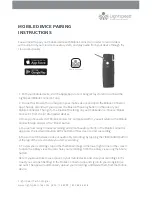
142 Managing administrative domains
Deleting all user-defined Admin Domains
When you clear the Admin Domain configuration, all user-defined Admin Domains are deleted, the explicit
membership list of AD0 is cleared, and all fabric resources (switches, ports, and devices) are returned to
the implicit membership list of AD0.
You cannot clear the Admin Domain configuration if zone configurations exist in any of the user-defined
Admin Domains.
To clear all Admin Domain definitions
1.
Clear all individual AD zone databases, in separate transactions, before proceeding with this
operation.
2.
Connect to the switch and log in as admin.
3.
Switch to the AD255 context, if you are not already in that context.
ad --select 255
4.
Enter the
ad --clear
command.
This option prompts you for confirmation before triggering the delete of all Admin Domains.
5.
Enter the
ad --apply
command to save the Admin Domain definition and directly apply the
definitions to the fabric.
Validating an Admin Domain member list
The
ad --validate
option allows you to validate the device and switch member list and flag all
resources that are from AD-unaware switches. You can use the
validate
option to list Admin Domain
members from AD-unaware switches and non-existing or offline Admin Domain members.
You can use the
validate
option to identify misconfigurations of the Admin Domain. For example, in
fabrics with a mix of AD-aware and AD-unaware switches, elements in the Admin Domain member list from
old AD-unaware switches are not enforced.
The Admin Domain validation process is not applicable for AD0, as AD0 implicitly assumes all unassigned
and AD-unaware online switches and their devices.
To list the switches and devices in an AD member list
1.
Connect to the switch and log in as admin.
2.
Switch to the AD255 context, if you are not already in that context.
ad --select 255
3.
Enter the
ad --validate
command.
ad --validate ad_id -m mode
If you do not specify any parameters, the entire AD database (transaction buffer, defined configuration,
and effective configuration) is displayed.
If you do not specify an Admin Domain, information about all existing Admin Domains is displayed.
The
-m
mode flag can be used as follows:
• 0 to display the Admin Domain configuration in the current transaction buffer.
• 1 to display the Admin Domain configuration stored in the persistent memory (defined
configuration).
• 2 to display the currently enforced Admin Domain configuration (effective configuration).
The following example validates the member list of Admin Domain 10 in the current transaction buffer.
sw5:AD255:admin>
ad --clear
You are about to delete all ADs definitions.
This operations will fail if zone configurations exists in AD1-AD254
Do you want to clear all admin domains (yes, y, no, n): [no]
y
sw5:AD255:admin>
sw5:AD255:admin>
ad --validate 10 –m 0
Содержание AE370A - Brocade 4Gb SAN Switch 4/12
Страница 1: ...HP StorageWorks Fabric OS 5 2 x administrator guide Part number 5697 0014 Fifth edition May 2009 ...
Страница 18: ...18 ...
Страница 82: ...82 Managing user accounts ...
Страница 102: ...102 Configuring standard security features ...
Страница 126: ...126 Maintaining configurations ...
Страница 198: ...198 Routing traffic ...
Страница 238: ...238 Using the FC FC routing service ...
Страница 260: ...260 Administering FICON fabrics ...
Страница 280: ...280 Working with diagnostic features ...
Страница 332: ...332 Administering Extended Fabrics ...
Страница 414: ...398 Configuring the PID format ...
Страница 420: ...404 Configuring interoperability mode ...
Страница 426: ...410 Understanding legacy password behaviour ...
Страница 442: ...426 ...
Страница 444: ......
Страница 447: ......
















































